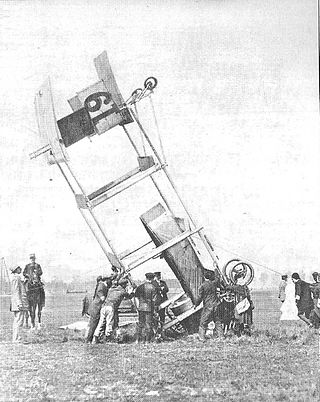
The Northrop YB-35, Northrop designation N-9 or NS-9, were experimental heavy bomber aircraft developed by the Northrop Corporation for the United States Army Air Forces during and shortly after World War II. The airplane used the radical and potentially very efficient flying wing design, in which the tail section and fuselage are eliminated and all payload is carried in a thick wing. Only prototypes and pre-production aircraft were built, although interest remained strong enough to warrant further development of the design as a jet bomber, under the designation YB-49.

The 14-bis, , also known as Oiseau de proie, was a pioneer era, canard-style biplane designed and built by Brazilian aviation pioneer Alberto Santos-Dumont. In 1906, near Paris, the 14-bis made a manned powered flight that was the first to be publicly witnessed by a crowd. It was also the first powered flight made anywhere outside of the United States, as well as the first powered flight by a non-Wright airplane.

The Roe I Triplane was an early aircraft designed and built by A.V. Roe which was the first all-British aircraft to fly..

The British Army Aeroplane No 1 or sometimes Cody 1 was a biplane built by Samuel Franklin Cody in 1907 at the Army Balloon Factory at Farnborough. It made the first recognised powered and sustained flight in the United Kingdom on 16 October 1908.

The 1907 Voisin biplane, was the first successful powered aircraft designed by aeronautical engineer and manufacturer Gabriel Voisin. It was used by the French aviator Henri Farman to make the first heavier-than-air flight lasting more than a minute in Europe, and also to make the first full circle. The first examples of the aircraft were known by the name of their owners, for instance the Delagrange I, or the Henri Farman n°1. Farman made many modifications to his aircraft, and these were incorporated into later production aircraft built by Voisin. The type enjoyed widespread success, and around sixty were built.

The Farman III, also known as the Henry Farman 1909 biplane, was an early French aircraft designed and built by Henry Farman in 1909. Its design was widely imitated, so much so that aircraft of similar layout were generally referred to as being of the "Farman" type.

The Bréguet Type I was an experimental aircraft built in France in 1909. It was Louis Bréguet's first fixed-wing aircraft design. Bréguet had previously had some success with two helicopter designs, one of which had been exhibited at the Paris Aero Salon in December 1908. Because of these machines, the Type I was at first known as the Bréguet Type III.
The Handley Page Type B was an unusual single-engined pusher biplane built by Handley Page at the commission of a Liverpool patent agent. Damaged before its first flight, Handley Page disowned it, but it was rebuilt and flew for a time in 1910 as the Planes Limited Biplane.
The Short No.2 was an early British aircraft built by Short Brothers for J.T.C. Moore-Brabazon. It was used by him to win the £1,000 prize offered by the Daily Mail newspaper for the first closed-circuit flight of over a mile (1.6 km) to be made in a British aircraft.
The Scottish Aeroplane Avis was a tractor monoplane built by Howard T. Wright in 1909. At that time Wright was one of England's foremost aircraft engineers, and had several monoplane aircraft under development. The Avis was shown at the 1910 Aero Exhibition in London and several examples were successfully flown during 1910.

The COW Biplanes were a pair of similar British tractor biplanes built to compete in the 1912 British Military Aeroplane Competition. They was not successful.
The Howard Wright 1910 Monoplane was an early British aircraft. It was one of a series of similar designs built by Wright, then one of Englands foremost aircraft engineers, between 1909 and 1910. Three of these were on display at the 1910 Aero show at Olympia. The noted English pioneer aviator and aircraft designer Thomas Sopwith learnt to fly in an example.
The Grahame-White Type VI was an early British military aircraft manufactured by the Grahame-White Aviation Company. Only one was built but after an abortive flight development was abandoned.

The NVI F.K.35 or Koolhoven F.K.35 was a two-seat fighter aircraft built in the Netherlands during 1926. It was completed and exhibited but, through a combination of ground accident and financial problems, never flown.

The Voisin Type de Course was an early French aircraft built by Voisin Frères. It was first flown early in 1910.

The Paulhan biplane was a French experimental aircraft designed in 1910 by the successful aviator Louis Paulhan in collaboration with Henri Fabre. The prototype became the second aircraft bought by the British War Office: two further examples, differing in constructional detail, were built.
The Voisin Type Bordeaux was an aircraft built by Voisin Frères in 1910, so-called because it was used by Juan Bielovucic to make a record-breaking flight from Paris to Bordeaux. The design differed significantly from previous Voisin designs in eliminating the forward-mounted elevator.

The pioneer era of aviation was the period of aviation history between the first successful powered flight, generally accepted to have been made by the Wright Brothers on 17 December 1903, and the outbreak of the First World War in August 1914.

The Schneider Henri-Paul was a French four-engined night bomber with an all-metal airframe. A single example was built and flown in 1922.

The Ireland Neptune was a four or five place pusher configuration biplane sold in flying boat and amphibian versions. Designed in the U.S. and first flown in 1927, well over 50 were built.














